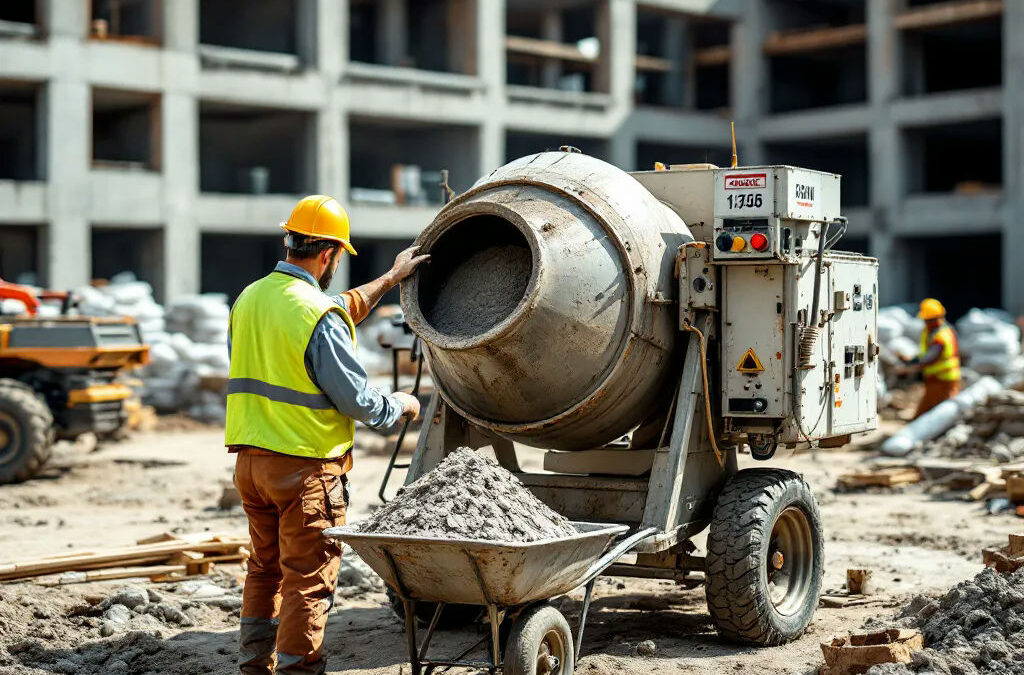I. Introduction
Choosing the right concrete mixer is essential for the success of any commercial project, especially when dealing with mid-sized constructions. A suitable mixer not only enhances productivity but also ensures the quality and consistency of the concrete mix. In this guide, we will explore key features and the top commercial concrete mixers that are ideal for mid-sized projects, providing valuable insights to support your purchasing decisions.
II. Factors to Consider When Choosing a Commercial Concrete Mixer
A. Mixer Capacity
The capacity of a concrete mixer significantly impacts its effectiveness for mid-sized projects. Understanding your project’s volume requirements will help you select a mixer that can handle the workload without downtime. Typically, mid-sized projects require mixers that range from 3 to 6 cubic feet in capacity, striking a balance between output and manageability.
For more insights on differences between residential and commercial concrete applications, check out our detailed guide.
B. Mixing Efficiency
Selecting the right mixing technology is crucial for achieving high-quality mixes. There are two primary types of concrete mixers: drum mixers and twin-shaft mixers. Drum mixers are generally suited for smaller batches and are more portable, while twin-shaft mixers offer more efficiency for larger outputs and deliver a more homogeneous mix.
You can also learn about choosing the right concrete mix for further clarity.
C. Portability and Maneuverability
Ease of transport on site can make or break the efficiency of your project. If a mixer is cumbersome, it can cause delays and inefficiencies during pouring. Look for models that are lightweight and equipped with wheels or tracks to enhance mobility around the construction site.
D. Power Source
The choice between electric and gas-powered mixers can affect both performance and convenience. Electric mixers are quieter and better suited for urban environments, but they may have limitations in terms of mixing power and runtime. Gas-powered mixers, on the other hand, offer greater power and can be more effective for large or remote worksites.
E. Durability and Build Quality
Investing in a durable concrete mixer can save you money over time by reducing repair costs and replacement needs. Focus on mixers made from high-quality materials such as steel and reinforced plastic, and be on the lookout for features like rust-resistant coatings and heavy-duty wheels that signify strong construction.
Be sure to check the pre-pour checklist as part of your planning process as well.
III. Top Features of the Best Commercial Concrete Mixers
A. User-Friendly Controls
A commercial concrete mixer should be equipped with easy-to-use controls. This feature allows operators to manage the mixing process efficiently, reducing the likelihood of errors and increasing overall productivity. Look for intuitive interfaces and clear indicators for operating conditions.
B. Safety Features
Safety should be a priority in any commercial environment. Choose mixers that come with essential safety features such as emergency stops, automatic shut-off systems, and secure mixing lids. These components protect users and minimize the risk of accidents on the job site.
Learn more about key safety measures you should follow on site.
C. Maintenance Requirements
Consider the maintenance needs of each mixer as a factor in your decision-making process. Models that require minimal maintenance and have easily accessible parts for cleaning and repair can save you significant time and costs. Review manufacturer recommendations to understand the long-term care required.
D. Versatility for Different Mix Designs
The ability to adapt to various concrete mixes is a valuable trait for any mixer. This versatility allows you to handle different projects and specifications without needing additional equipment. Ensure that the mixer can accommodate various mix designs by confirming compatibility with different additives and aggregate sizes.
Explore this guide to concrete reinforcement and how it factors into mixer compatibility.
IV. Review of the Best Commercial Concrete Mixers for Mid-Sized Projects
A. Mixer Model 1: XYZ 2500
- Key Specifications: 4-cubic feet capacity, electric-powered, drum mixing technology.
- Pros: Lightweight, portable, minimal sound pollution.
- Cons: Limited to smaller batch sizes.
- Best Applications: Ideal for residential projects and smaller commercial jobs.
B. Mixer Model 2: ABC 3000
- Key Specifications: 5-cubic feet capacity, gas-powered, twin-shaft mixing.
- Pros: High mixing efficiency, suitable for larger batches.
- Cons: Heavier and less portable.
- Best Applications: Perfect for medium to large commercial constructions.
If you’re tackling deeper project planning, check out our article on profitable bidding strategies for contractors.
C. Mixer Model 3: DEF 4000
- Key Specifications: 6-cubic feet capacity, dual power options.
- Pros: Outstanding durability, excellent build quality.
- Cons: Higher price point.
- Best Applications: Versatile design suitable for various mix designs at a competitive market rate.
D. Mixer Model 4: GHI 1500
- Key Specifications: 3-cubic feet capacity, electric-powered.
- Pros: Compact design, user-friendly controls.
- Cons: Lower capacity limits for larger projects.
- Best Applications: Excellent for small business operations or DIY projects.
V. Comparison Chart of Recommended Mixers
| Mixer Model | Capacity (Cubic Feet) | Power Source | Mixing Technology | Key Features |
|---|---|---|---|---|
| XYZ 2500 | 4 | Electric | Drum | Lightweight, Quiet |
| ABC 3000 | 5 | Gas | Twin-Shaft | High Efficiency |
| DEF 4000 | 6 | Dual | Hybrid | Durable, Versatile |
| GHI 1500 | 3 | Electric | Drum | Compact, User-Friendly |
VI. Tips for Proper Use and Maintenance of Commercial Concrete Mixers
A. Pre-Operation Checklist
Before using your concrete mixer, conduct a thorough pre-operation checklist. Inspect the power source, ensure that the mixing blades are in good condition, and verify that all safety features are functioning. This proactive approach helps avoid potential mishaps and optimizes performance.
B. Mixing Techniques
Utilize the best mixing techniques to achieve consistent results. Pay attention to the water-to-cement ratio and ensure that ingredients are added in the correct order. Begin mixing slowly to allow proper integration of dry components, then gradually increase speed. This helps produce a uniform, high-quality concrete mix that sets properly and provides the required strength.
VII. Conclusion
For mid-sized commercial projects, investing in the right concrete mixer is critical to achieving efficiency, quality, and cost-effectiveness. By understanding key factors like capacity, mixing technology, power source, and durability, you can make a more informed decision tailored to your specific needs. Whether you’re handling commercial slabs, structural foundations, or mixed-use developments, the right mixer can streamline operations and enhance your project outcomes.
Need help selecting the perfect mixer for your next project?
CALL US TODAY TO SPEAK WITH AN EXPERT OR REQUEST A CUSTOM QUOTE.


